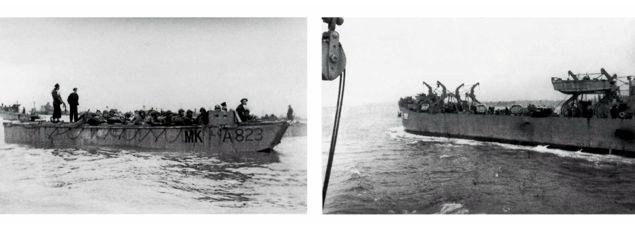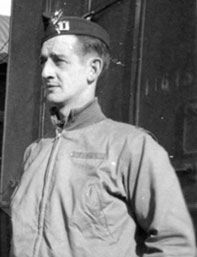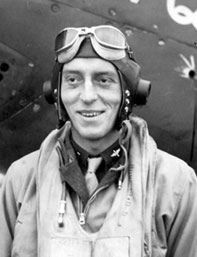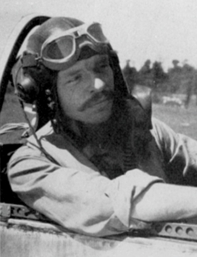England to France
By 1st Lt. Gabriel M. Bernstein and Capt. Albert D. Fowler
After about four months at Colchester, the group, which had remained intact since leaving Salem, Oregon, moved about sixty miles southeast of London, near a small town named Headcorn. All throughout the States the accommodations of each field had included wooden barracks, concrete runways hangars and office buildings. Colchester, likewise, had provided those conveniences, except in the one instance of Nissen Huts being substituted for wooden barracks. So it was that the field at Headcorn necessitated the initiation of the group to foxholes, pyramidal tents, grass runways and hardspot workshops. But the bivouac excursions undertaken in the States had prepared the men to some degree, to those conditions, and, within a week of the, squadron's arrival things were being run with their normal efficiency. At about that time, too, it was finally decided which Air Force the Group was to serve under. For some time the reins had been changing hands between the Eighth and Ninth Air Forces, and now it was announced that the Ninth was going to keep them. So it was as a unit of the Nineteenth Tactical Air Command, under the Ninth Air Force, that the Pioneer Mustang Group joyously greeted the news of the invasion of France on June 6th 1944.

The majority of the group's ground personnel were transported to France by troop ship and othes made the English Channel crossing in LSTs on their way to A-2, an advanced landing ground near the town of Cricqueville-en-Bessin. (William W. Louie)
On June 14th, the first echelon of men left Headcorn, via a miscellany of vehicles, and proceeded to Portsmouth, the South England Marshaling Area, where they were made ready to cross the English Channel. The crossing, made in LST's, was rough enough to justify, in the minds of the men, the notorious reputation of that body of water and the enormity of the Allied Naval forces engaged in the work of invasion, was enough to awe the most, phlegmatic person. Landing was made on Omaha Beach after a period of awaiting the caprices of tide and weather, and immediately a short trek was made to A-2, field boasting a steel-mat runway, and situated about three miles inland near the town of Cricqueville-en-Bessin. The squadron move from England to France was made in three echelons, with the first two going over by LST, and the last one by C-47; and it was not till July 3rd that the entire squadron was once more assembled.
From the time this foot-hold was gained in enemy territory, the long-range missions to Germany became interspersed with fighter patrol missions over more immediate vicinities. That factor, combined with the advantage of long, early summer days, considerably augmented the destructive power of the P-51 on the enemy and the Red Ass Squadron justifiably claimed a reasonable share of the credit for driving the Germans through France and towards the German border. From Normandy to Brittany, to Marne, the Group followed the push through France, and, with the advent of the year 1945, the success of the invasion had long been assured and the final stage of the war in Europe was in sight.
The Drive to Germany
It was while the Squadron was in the Province of Marne that the Germans effected a surprise counter-attack in the area between Duren and Trier. It was a short-lived hope for the Germans, for it is a matter of history that within six weeks the push had not only been repulsed, and the bulge deflated, but that sector of the enemy front had been driven back even beyond their original position. And again the Red Ass Squadron stood modestly in line for at least a crumb of the acclaim. From the first days of the counter-attack, the pilots had been relieved of their normal mission routine and assigned in a protective and assisting capacity to the 20th Corps Area of the Third Army in the vicinity of Trier. The record chalked up by the squadron previous to that new assignment, although impressive enough to justify commendation from the highest military office, became as a mere bagatelle to the list of destruction which continued to come daily from the Trier Area. When the onslaught was over, and the German line once more under control the reversion to normal combat flying was like a vacation to the pilots and the rest of the squadron who had been straining at their maximum capacity for weeks without relief. It was not long after that period that the Third Army initiated the last phase of the war by establishing a footing on the west bank of the Rhine River. The Third Army was soon followed by other Allied Armies, and they, in turn, were soon followed by the Pioneer Mustang Group.
This time to Ansbach where accommodations as closely approximated those of a country club as any Air Corps unit could hope to encounter.
The Group could very well have been in Germany several weeks before it actually was, but the delay in going there was caused by the fact that, as fast as a field was selected for occupation by the Group it would become outdistanced by the front lines, and a new and closer one would have to be picked. One was finally decided upon just outside Mainz, and the squadron realized a two-year dream of occupying German territory. Living and working conditions were slightly improved at that field, but the men had little time to appreciate the difference, for, within three weeks they were moved again. This time to Ansbach where accommodations as closely approximated those of a country club as any Air Corps unit could hope to encounter. Three-story stone buildings, rambling for acres and divided into large wings, provided commodious apartments for the men; and hangars, which expressed the final word in modernity, housed all the offices and workshops for the squadron. But the wallowing in comfort was a minor pleasure to the joy which was daily experienced from the sources of war news.
The end of the war was now computable in terms of days, or even hours, and, when, on the 7th of May, announcement was made that hostilities had ceased, the men went into a siege of celebration that would have done credit to the expiration of a ten years' war. But any doubt as to whether the squadron was entitled to such a celebration could be assuaged by a glance at the record of accomplishment which had been compiled during the two years and seven months of the squadron's organization. In that time, 560 combat missions had been flown for a total of 18,861 hours and 20 minutes, and 298 enemy aircraft had been destroyed, exclusive of a staggering number of damaged and probably damaged. As against those figures of achievement, the Squadron's losses amounted to 22 pilots, including those killed in action, missing in action, and those killed in accidents other than in combat. All in all, it was a glorious record by an exceptional squadron, and whatever its fate was to be after the cessation of war in the European Theater, it would be to its irrevocable credit that if had caused the Germans to regret the birth of the Red Ass Squadron.




